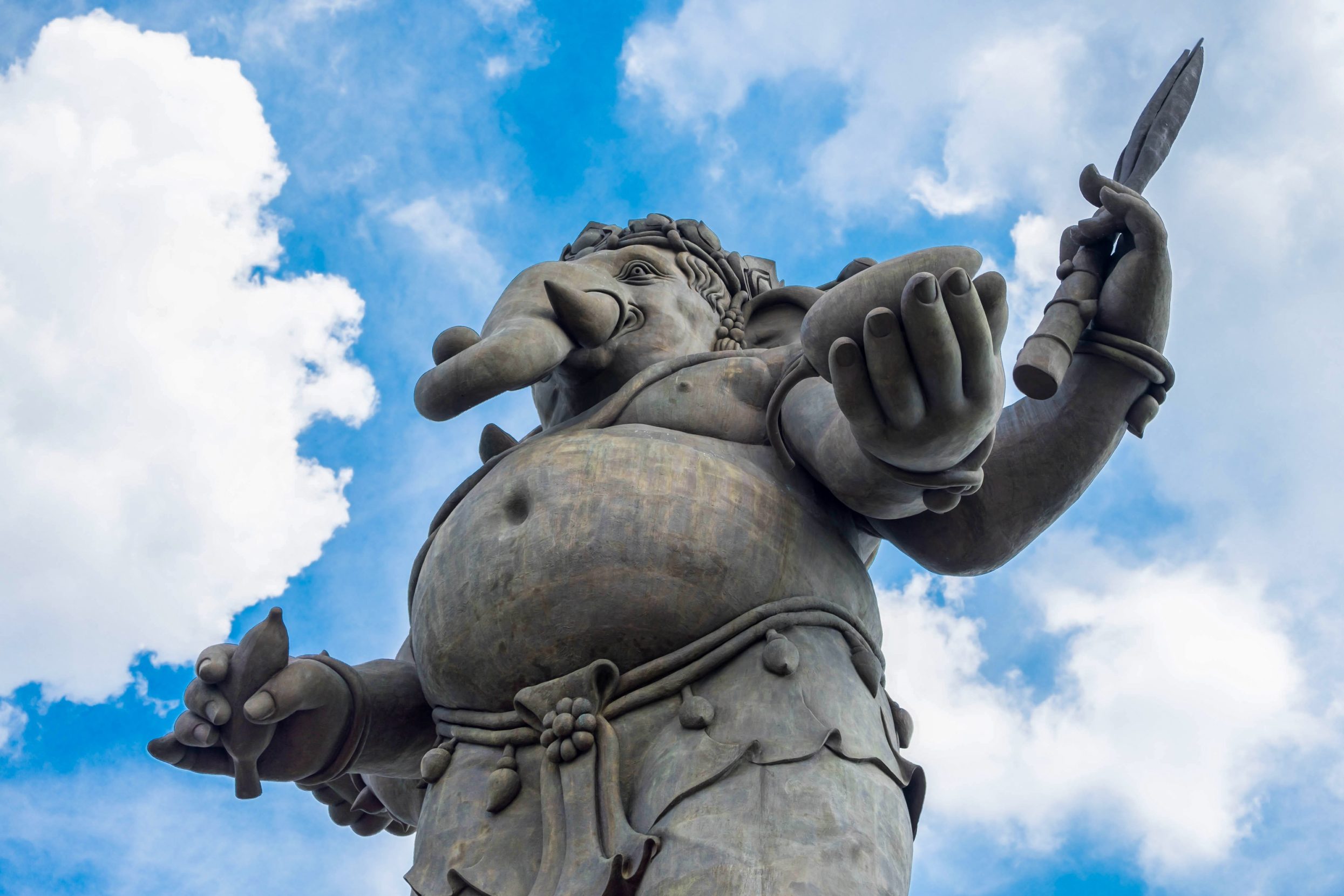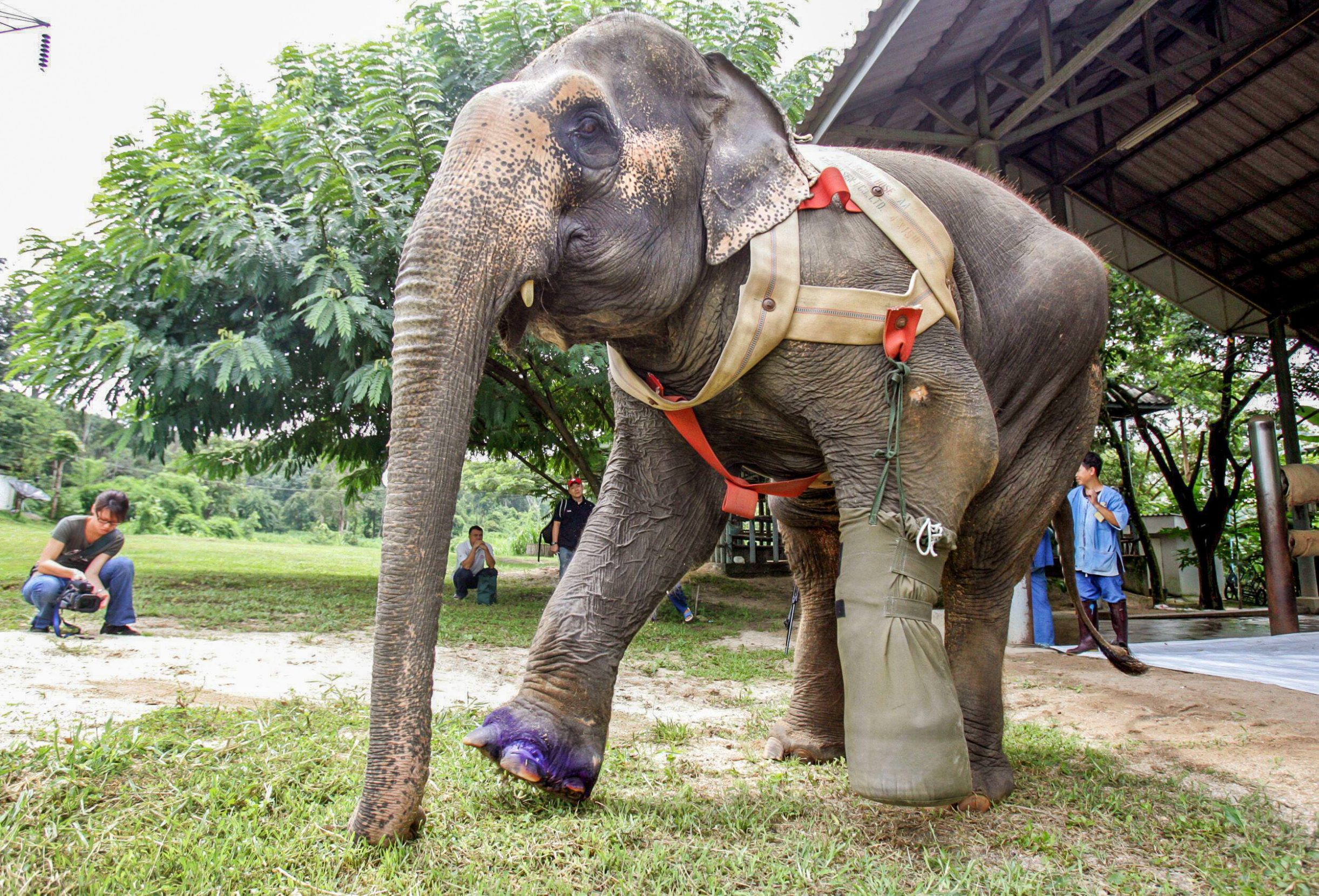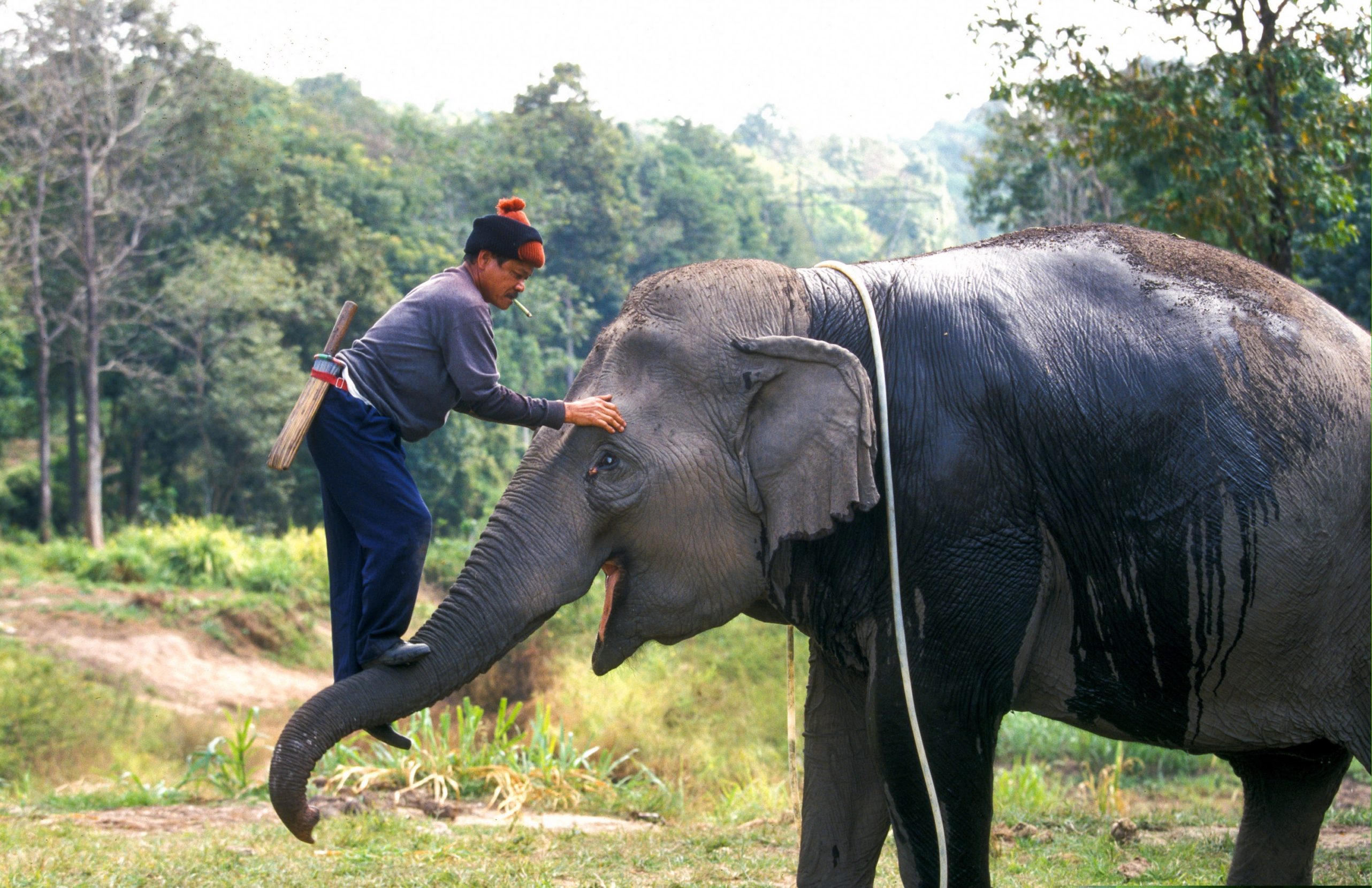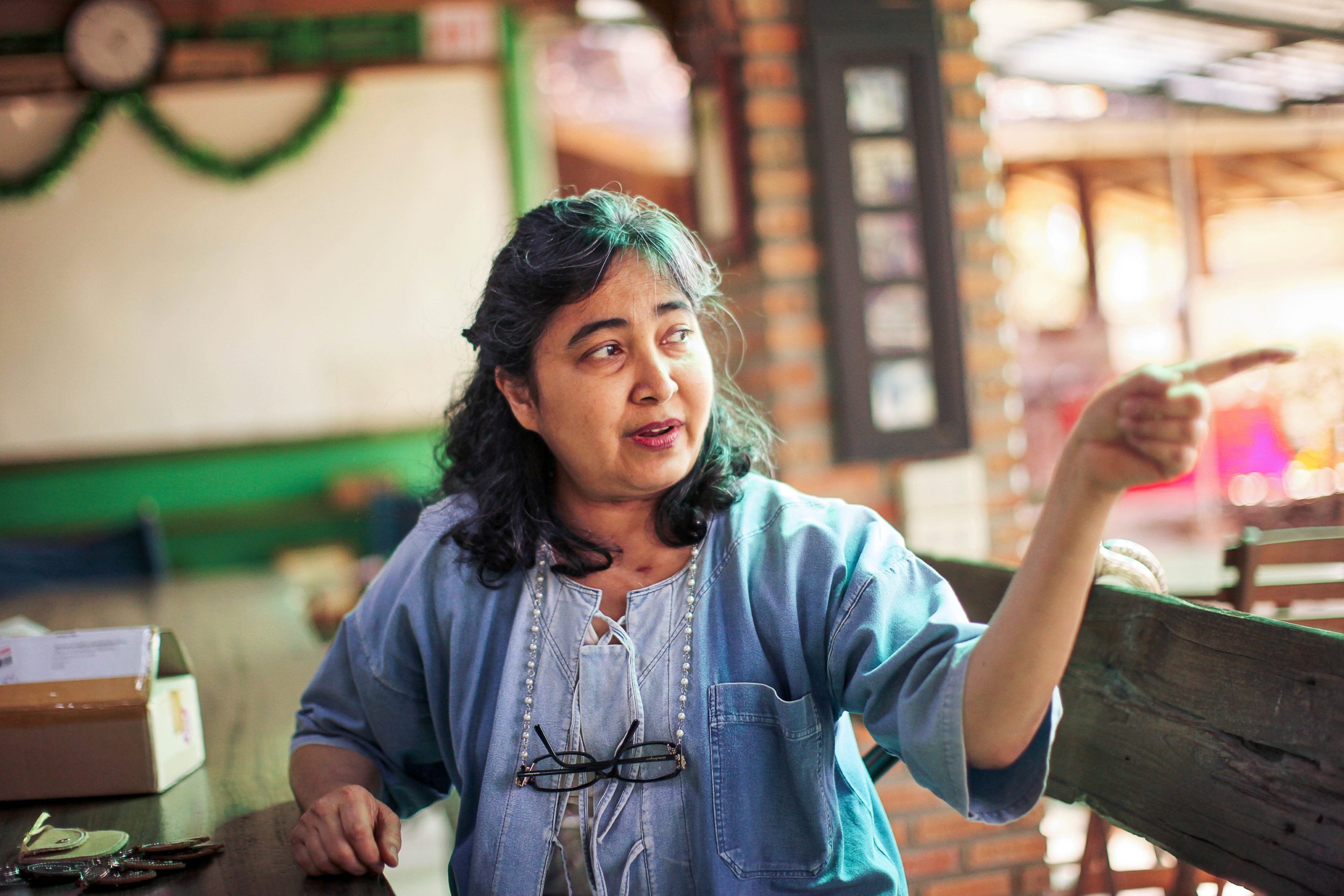Support Hidden Compass
Our articles are crafted by humans (not generative AI). Support Team Human with a contribution!
KHAO YAI, Thailand – circa 1965
Soraida Salwala was in the car with her father. After a short holiday in Khao Yai National Park, where she had played in the forest and tried to climb the limestone cliffs, it was time to go back home. The car ride was long and boring for an eight-year-old, and she tried to distract herself by staring through the window at the blur of cars and paddy fields.
Suddenly the monotonous view was interrupted by a large, dark mass, slumped by the side of the road. A man was standing next to it, wailing. Soraida was shocked — she wasn’t used to seeing adults cry.
As the car slowed down, she noticed two long, white tusks.
“Stay inside, Soraida,” said her father, the wrinkles in his forehead deepening as he slammed the car door shut. Soraida could see him talking to the man, but she couldn’t make out their words.
By the time her father came back to the car, she was burning with worry.
“What happened to Uncle Elephant, Dad?” she asked.
He took longer than usual to answer. When he finally spoke, he said, “Uncle Elephant was hit by a truck.”
Soraida paused to absorb the information. She knew what to do in these situations: She had grown up with health problems, and had been in and out of hospitals since she was a baby.
“We need to take him to the hospital,” she reasoned.
Her father tried to contain a smile. He put his hand over hers.
“How could we?” he said gently. “He is too big. He won’t fit in the car.”
And as hard as she tried, she could not think of a solution.
As they drove away, Soraida heard a loud bang.
Her father said, “Uncle Elephant is now in heaven.”
~~
CHIANG MAI/LAMPANG, Thailand – 2022
It’s 7:20 a.m., and I’m waiting in my hotel lobby. It contains all the fixtures of backpacker-friendly accommodations in Thailand: a couple of beanbags, a shelf filled with tattered secondhand books, and a stand with leaflets advertising guided tours and activities.
An elephant stares at me from a pamphlet titled “Elephant Sanctuary. Once in a lifetime experience!” In the picture, a young blonde in a bikini is standing next to the enormous animal, her arms around its trunk. Farther down the page, the activities on offer are listed: “Elephant shows twice a day. Bathing with elephants. Elephant painting.”
Such sanctuaries, I’ve learned after living in Thailand for five years, are as popular an attraction for travelers as tuk-tuks and street food stalls. As someone with a deep-seated love of animals, I’ve long been tempted to visit one of these places.
Yet I’ve managed to stop myself each time. I have a passion for animal rights, which made me a vegan at 13, and the reports of abuse that plague many of Thailand’s elephant “sanctuaries” were enough to hold me back. These places are supposed to provide safe homes for the intriguing giants — to offer them solace and succor after years of abuse or exploitation, to foster respectful visitor encounters, to lead the campaign to treat elephants in an ethical way.
Too often, however, just the opposite occurs. According to a 2020 investigation by World Animal Protection, a nonprofit animal-welfare organization, 70 percent of Thailand’s captive elephants are kept in severely inadequate conditions. The same investigation revealed that many “sanctuaries” and “rescue centers” do not act in the best interest of their residents, offering rides to guests, chaining elephants tightly, and refusing to provide information about how their animals were acquired.
One day recently, however, I came across an article about an elephant hospital in Lampang, about an hour’s drive from the northern city of Chiang Mai. I realized I’d found the place that I needed to go — a true elephant sanctuary.
Established in 1993 by Soraida Salwala, who’d grown up to be a conservationist, the Friends of the Asian Elephant Hospital is the world’s first hospital for elephants. It has treated more than 5,000 elephants for everything from eye infections to knife wounds to cancer. Today Salwala and her staff of 16 — vets, nurses, technicians, and mahouts (traditional elephant riders and trainers), along with volunteers and vet students — care for 10 elephants that have been injured or fallen ill as a result of work, abuse, or neglect.
As excited as I am to see the elephants, I also can’t wait to meet Salwala — a true pioneer in animal welfare and conservation.
I hear a honk outside, and know that my ride has arrived.
~~
Lyn, my driver for the next few days, pulls up at 7:30 sharp in a small blue car. She’s a slight, friendly woman in her 40s, dressed in jeans and a T-shirt.
We enter the highway traffic, and the urban cityscape soon gives way to lush paddy fields and craggy mountains that tower above the morning mist.
I wish for a moment that I could experience life from her perspective, towering above the tropical landscape like jungle royalty.
“You are interested in elephants?” Lyn asks, catching my eye in the rearview mirror. I nod. She’s clearly used to foreigners’ fascination with them.
Elephant tourism is a lucrative industry in Thailand. Before the COVID-19 pandemic began, in early 2020, animal-welfare organizations estimated the value of elephant-based entertainment here to be over $500 million (USD) a year.
“Elephants are sacred in Thailand,” Lyn says. “Do you know the story of Queen Maya?”
I do not.
“She was a good queen,” Lyn says, “but she could not conceive a baby. So when she and the king were getting older, there was no heir to inherit the crown. One night, when the moon was full, she had a dream. A white elephant came to her holding a lotus flower. The next day she was pregnant with a baby boy, who grew up to become the Buddha.”
I’d never heard this story, but I’m keenly aware of how important elephants are in Thai culture. For centuries they’ve been ubiquitous here — worshiped as deities and symbols of good fortune, used for transportation, exploited for labor, and, most recently, tethered to the country’s tourism industry.
As we drive I can see stylized statues of elephants decorating median strips and streetlights. Dressed in tasseled caparisons and ornate conical crowns, with golden rings around their tusks, they bow to the skies and raise their trunks in the air.

Though Buddhism is Thailand’s predominant religion, many ancient temples and shrines here are dedicated to the elephant-headed Hindu deity Ganesha (thanks to the overlapping Buddhist/Hindu cosmology). This statue of the god — known to Thais as Phra Phikanet — is in Chachoengsao, some 25 miles east of Bangkok. Photo: Chaikrit Ingkawaranon / Alamy.
~~
As the road becomes narrower and more serpentine, passing through dense and mossy pine forests, black-and-yellow signs warn drivers to beware of roaming elephants.
“Are there really wild elephants around here?” I ask.
“Some,” Lyn says. “In the past there were many. Now there are fewer.”
I later learn that this is a profound understatement. In the early 20th century, an estimated 100,000 Asian elephants lived in Thailand (then called Siam). Today the Asian elephant is an endangered species, according to the International Union for Conservation of Nature’s Red List. In Thailand, fewer than 4,000 remain — about half in captivity. About 20 percent of the remaining wild population is thought to live in Chiang Mai province.
Gravel crunches beneath the car’s wheels as Lyn slows to find a parking spot. We’ve arrived.
~~
The Friends of the Asian Elephant Hospital is a low building that includes a cafeteria, a visitors’ center, and the staff’s lodgings. It’s surrounded by elephant enclosures and 200 green acres. Birds chirrup overhead. The whole campus smells of dung and grass.
I’m greeted by Tossapol Torsri, aka Dr. Ton, an energetic young veterinarian with neatly cropped black hair. He looks thrilled to see new people at the center, which he tells me has been hit hard by the COVID pandemic.
Creuathong Kayan, or Dr. Kay, the current head veterinarian, is away today. To my disappointment, so is Salwala. I ask where she is, hoping I can stay until she returns.
“She is in Bangkok,” Dr. Ton says vaguely. “Would you like to meet Motala? We were about to do her daily wound cleaning.”
Of course I would. Motala is something of a celebrity in wildlife-conservation circles — a 60-year-old female who lost her foot in 1999, when she stepped on a landmine at a logging camp on the Thailand-Myanmar border. (Logging of natural forests has been banned in Thailand since 1989, but it still occurs, albeit at a lower rate than it used to.)
When we reach Motala’s enclosure, she’s calmly munching on grass. I can barely contain my excitement — it’s the first time I’ve been this close to an elephant, let alone a famous elephant. She blinks in my direction, as if to acknowledge my presence. I wish for a moment that I could experience life from her perspective, towering above the tropical landscape like jungle royalty.
Then a close look at Motala brings me back to earth. Her dark skin is dotted with pink sores and scars. Her left front leg, wrapped in bandages, ends at the ankle. Resting against the back wall of the enclosure is her custom-made prosthetic leg — a 45-pound plastic contraption, reinforced with steel rods and a sturdy rubber sole. As the prosthesis requires regular and costly upkeep, it’s now used only occasionally — a casualty of the hospital’s pandemic-related financial struggles.
Despite her injuries, Motala radiates a quiet, dignified energy — an air of aristocracy, even. Her brown eyes, framed with wrinkles and thickly lined with eyelashes, watch me with curiosity as she dumps a trunkful of sand on her back to disperse the flies that are swarming around her.
Motala’s minders — Dr. Ton, a veterinary assistant, and a thin, jovial mahout named Somchai — lead her to a paved section of the enclosure that’s stocked with veterinary equipment. They don rubber gloves, and as Somchai gently removes Motala’s bandages, Dr. Ton and the assistant fill two syringes with viscous substances, one yellow and one dark brown.
“She has some lesions on her front right leg,” Dr. Ton explains. “Unfortunately, she has to put a lot of weight on it to compensate for the other leg.”
After they thoroughly wash the wounds with water, Dr. Ton applies iodine solution and a thick antibiotic ointment to the area, which temporarily dyes Motala’s skin yellow.
Somchai pats her gently on her right side. Motala responds by standing on her hind legs and resting her head on the enclosure’s six-and-a-half-foot-high iron fence, her front limbs now within easy reach of Dr. Ton. This is clearly a frequent procedure.
“It can take many years for their wounds to heal completely,” says Dr. Ton soberly, as he cleans Motala’s stump. Motala lowers herself back onto the ground. She reaches out to me with her trunk, and I place my palm on it, feeling the booming vibration of her breath rippling through my body.
As we leave the enclosure, I sense Motala’s peaceful brown eyes following me. I wonder if her other injuries — the kinds you can’t see — will ever truly mend. Even at a real sanctuary like this one.

In Lampang, Thailand, an Asian elephant named Motala takes her first steps in a 45-pound, custom-made prosthesis. The 60-year-old female, who lost her left front leg to a landmine in 1999, has become a celebrity in wildlife conservation circles. Photo: Adrees Latif / Reuters.
~~
A thousand feet or so to the right, another enclosure holds a very small elephant — a baby whose 11-year-old mother gave birth at a tourist camp.
Female Asian elephants are better suited to breed when they’re at least 14, says Dr. Ton. “She was not mature enough to have a baby, or to look after it. So we have been helping them both — baby Thanwa and her mother, Nam Wang.”
Baby elephants are a hot commodity on the illegal global wildlife market, where they have reportedly fetched as much as $33,000 (USD). Easier to train than adults, with decades of work (and potential earnings) ahead of them — Asian elephants can live into their mid-50s (Motala is an anomaly) — they’re often targeted for capture in the wild, along with adult male Asian elephants, which are poached for their ivory.
As a protective measure, the Friends of the Asian Elephant Hospital doesn’t allow visitors near Thanwa’s enclosure, including me. Dr. Ton, beaming like a proud father, shows me some videos of the baby elephant on his phone.
He checks his watch and says, “It’s 10 o’clock. Time for Chand Nuan’s electroacupuncture session.”
~~
Chand Nuan is a middle-aged elephant, a little over seven feet tall. Her ears and back are whitish pink with gray spots, as if her skin had run out of gray ink — a common symptom of aging in Asian elephants. She’s anxiously swaying from side to side.
Since 2019, when she was attacked by another elephant in a tourist camp, she hasn’t lain down to sleep; most nights she sleeps while standing. The veterinarians think she also has circulatory problems, hence the electroacupuncture — a common enough treatment in the equine world, but still a relatively experimental form of therapy for elephants.
An assistant climbs a ladder onto a metal stand about eight feet tall, carrying a rectangular black machine the size of a briefcase, topped with a series of knobs and dials. The front of the machine is connected to dozens of long, tangled white, orange, and purple wires. After the assistant carefully unwinds them, he throws the ends down, so that they drape over Chand Nuan’s back within Dr. Ton’s reach.
Dr. Ton connects each wire to a sterile needle that he inserts into points on Chand Nuan’s back, shoulder, and neck. A few minutes later, she’s adorned with a colorful web. She doesn’t seem to mind.
Dr. Ton turns the machine on, and for the next 20 minutes it sends invisible microcurrents through the elephant’s muscles to promote circulation. Chand Nuan’s swaying accelerates slightly, and her beanie-wearing mahout, Ubon, who looks no older than 20, rests his hand softly on her right temple. Furrowing his brow and abstaining from the rest of the team’s lighthearted chat, he remains by her side until the end of the treatment.
Somehow they’d found each other.
Afterward, Dr. Ton stuffs a handful of vitamin tablets into a football-size lump of tamarind. Chand Nuan picks it up with her trunk and pops it into her mouth as if it were a jelly bean.
“Tamarind is her favorite,” says Dr. Ton with a laugh.
~~
The next day I’m back at the hospital at 10 a.m.
This time I’m received by Dr. Kay, the head veterinarian. Now in her 40s, she joined the hospital 20 years ago as an intern, and never left. She walks assertively toward me in green scrubs, with her hair pulled back and a firm expression on her face.
I try my luck and ask whether I can meet Salwala today — only to be told that she is still away. I try to come to terms with the idea that perhaps I won’t get to meet her after all.
Dr. Kay takes me to see Plai Bobo, a 19-year old male kept in a secluded enclosure at the far end of the premises. Usually called just Bobo, he weighs about four tons and stands eight feet tall. His trunk is flanked by two long, pointed tusks.
“When he arrived he was in a bad condition,” says Dr. Kay. “His ears were almost gone as a result of an infected wound. We cured his physical injuries, but the abuse he experienced at the tourist camp left deeper scars.”
Post-traumatic stress disorder (PTSD) is common in Thailand’s captive elephant population. According to a 2019 case study by Tufts University, 55 percent of the elephants at a sanctuary in northern Thailand exhibited signs of PTSD, which can be triggered when an elephant is prematurely separated from its mother, physically abused, or has its movements chronically restricted.
A tall, middle-aged man walks toward us from Bobo’s enclosure. His skin is sun-weathered, his build athletic.
“This is Lamin, Plai Bobo’s mahout,” says Dr. Kay. “He is originally from Myanmar but has been with us for 12 years.”
If he hadn’t been, I soon learn, a tragedy might have occurred two years ago.

Mahouts — like this one at the Friends of the Asian Elephant Hospital in Lampang — are traditional elephant riders and trainers. Many come from ethnic, animist Karen tribes in Myanmar or western Thailand. Using centuries-old caretaking techniques, they often form deep emotional bonds with their wards. Photo: BSIP SA / Alamy.
~~
On a stiflingly humid afternoon in 2020, Lamin was sweeping Bobo’s enclosure. For 10 years he’d fed Bobo, washed him, exercised him, cleaned his enclosure, and of course kept him company.
Bobo would become anxious without Lamin, so the mahout — who slept in a tent next to his ward — rarely took time off. And if he was being honest, he struggled being away from Bobo too. Their connection was difficult to explain to others. No one understood Bobo better than Lamin, who, like many mahouts here, is from an ethnic Karen tribe and brings with him centuries of ancestral knowledge about caring for the creatures.
The enclosure — several thousand square feet of open space — was bordered by an iron fence at the front and sides. In the back, it was separated from a forest by a 10-foot-tall, nearly perpendicular incline, densely covered with vegetation.
When Lamin had almost finished sweeping, he heard the low rumble of a truck approaching. This was bad news: Loud noises made Bobo deeply afraid — a symptom of his PTSD.
Bobo stood still, but his tail stuck out in a straight line, and his trunk twisted around his left tusk. As the sound of the truck grew nearer and louder, he clambered halfway up the incline at the back of the enclosure, toward the forest, ignoring Lamin’s calls.
Lamin knew that he had to call for help. It was unlikely that Bobo would climb high enough to escape — but if he did, the consequences could be devastating. The hospital was surrounded by multiple-lane highways and farms with electric fences — a potential death sentence for a roaming elephant.
Lamin ran down the steep path leading to the visitors’ center and was relieved to find Dr. Kay, who promptly called Salwala. As the matriarch of the hospital, she holds more sway over the elephants than the other team members. Salwala was in Bangkok, but she gave directions through Dr. Kay’s phone.
“Bobo, dear!” she called out as Dr. Kay held her phone toward Bobo.
The elephant looked up and stopped twisting his trunk.
“Stay where you are, all right?” Salwala said. “We will give you some food and water, and then you will go back home, OK?”
Bobo grumbled, and eventually his tail wilted. At that point Lamin decided it was safe to approach him. He poured Bobo some water in a bucket and handed him a bunch of bananas, which Bobo devoured whole.
Then they walked back to the enclosure together.
~~
“I was 12 years old when I started taking care of elephants in my village,” says Lamin, as he sits next to his sleeping tent. “My uncle taught me. We are Karen, and it is part of our tradition to feed elephants, to look after them. When I was young it was a common job. But today only a few children are brought up to work with elephants.”
The Karen people, concentrated in southern Myanmar and along the Myanmar-Thailand border, have cohabited with elephants for centuries, developing techniques to train and care for them. In the 19th and 20th centuries, the British employed Karen people to harvest lumber using elephants.
In recent decades, as logging laws began prohibiting such logging, many Karen mahouts and their elephants have turned to the tourism industry.
But tourists vanished during the COVID crisis, plunging thousands of the mahouts into unemployment — and provoking a mass exodus back to Karen villages. Faced with the crushing costs of rent and food in the previously touristed areas, an estimated 1,000 elephants and mahouts trekked as far as 100 miles home, over hills, across roads, through forests.
Lamin and Bobo were saved from this fate because the Friends of the Asian Elephant Hospital does not rely solely on tourism. Yet the pandemic’s financial repercussions here have been profound. To keep the hospital afloat, all the staff accepted salary cuts and learned to grow their own food on the premises, taking turns tending the campus’s new vegetable patch.
I think about how daunting it must have been for Lamin to befriend a badly injured and traumatized Bobo 12 years ago, when he was hired by the hospital to be Bobo’s mahout after the elephant was admitted.
Lamin says it took six full months until Bobo came to trust him. Now, he says solemnly, his hand resting on his chest as he looks over at Bobo, “He is my brother.”
If everything in nature has a soul, as some animist Karen communities believe, then I imagine that Lamin and Bobo would be soulmates. Somehow they’d found each other. Together, they’d found comfort and safety. Refuge.
~~
“What happened to Uncle Elephant, Dad? … We need to take him to the hospital.”
On the last day of my visit, Dr. Kay leads me into a room next to the cafeteria, which is decorated with paintings and statues of elephants — gifts from previous visitors. Seated at the far end of the room is the elusive Salwala. She gestures for me to sit at the other end, to maintain social distance.
Wavy, graying hair frames her soft features and expressive eyes, which seem tired. She sees me notice a walking aid next to her chair.
“I have been away receiving treatment for my chronic lupus and multiple sclerosis,” she says. “It’s hot here, and there is a lot of [air pollution in this region], which I am allergic to. But I am still alive — probably because of the elephants.”
As Salwala speaks about her work, she occasionally interrupts our conversation to communicate with individual elephants and their handlers through a walkie-talkie.
She tells me that the hospital’s 30th anniversary is approaching, smiling proudly and wearily at the thought. Then she tells me a series of stories about her career as a conservation activist, describing how she refused to vacate a construction site for a new oil pipeline projected to pass through forests inhabited by wild elephants. And how she exposed organizations that trafficked baby elephants. Every anecdote is punctuated by a proud “They hate me,” meaning loggers, government officials, ivory traders. Anyone and everyone who has subjugated her beloved elephants.
Salwala says the overall situation in Thailand has improved since she started her work. Smuggling, trafficking, and abuse are far less common than they were 30 years ago.
“But not as much as I hoped [they would be by now],” she says ruefully. Traffickers “still smuggle elephants from across the Myanmar border — the ones with the tusks — so they can slaughter them and sell them.”
Camps where elephants are trained to perform grueling shows for tourists remain commonplace as well.
“Some claim that they are sanctuaries,” she says. “‘We don’t chain the elephants.’ But they do. At night, of course.”
Salwala says she’s worried that her hospital won’t survive. In the past, donations from visitors made up a large chunk of its funding. In 2017 a windfall in public donations pulled the hospital back from the brink of insolvency and closure.
But those contributions have evaporated since the pandemic began. There’s now barely enough to cover the hospital’s operating costs. A single elephant consumes up to 300 pounds of food every day. Add in staff salaries (even recently reduced ones), medicine, equipment, and building maintenance, and it costs more than $28,000 (USD) a month to keep the hospital open.
Most of all, she worries that the number of captive elephants in Thailand continues to grow while the number of wild elephants shrinks. Thais claim to love and respect elephants, she says, yet they blame wild populations for causing car accidents and destroying farmers’ crops.
“Is it the fault of the elephants?” she asks. “No. We invaded their territory, their homes.”
Yet Salwala remains defiantly optimistic. When she started the foundation in 1993, she says, “I told the public, ‘Within 20 years elephants will be gone if we don’t do something.’
“But we have done something.”

Pioneering conservationist Soraida Salwala, seen here in 2012, founded the Friends of the Asian Elephant Hospital in 1993. At the time, it was the only facility of its kind in the world. Photo: Fredrik von Erichsen / Alamy.
~~~
On our way back to Chiang Mai, Lyn asks if we can make a stop to “pay our respects.”
I say sure, and Lyn soon pulls off the highway and parks beside a temple. We get out of the car and walk toward a round building, then climb a few steps onto a stone platform and breathe in the smell of burning incense. A bronze Ganesha sits cross-legged at the center of the platform.
As Lyn kneels down in prayer, I look at the elephant god. Draped in marigold flowers, his four arms arched into a graceful shape, he seems to return my gaze, bronze eyes twinkling.
I think of Motala’s deep brown eyes, watching me peacefully from her hospital enclosure. Ganesha and Motala are obviously very different — one is holy, the other earthly; one revered, the other abused; one immortal, the other endangered — yet there’s a similarity to them beyond their ears, tusks, and trunk. An essential, spiritual sameness.
Many elephants today, in Thailand and elsewhere, lead lives of suffering. Their pain is often inflicted, paradoxically, by the humans who are fascinated with them. Collectors pay fortunes for ivory, tourists flock to see them perform tricks, and the cycle repeats itself, over and over again.
But the hospital offers hope of an alternative. I close my eyes and visualize Motala again: hobbling on her three good legs, her skin marked by age and injuries as she swats the flies away with sand. She may not be whole now, and never will be again. But she is home now. And she seems to have found a measure of peace.
Of sanctuary.
Ana Norman Bermúdez
As a freelance photographer and writer, Ana Norman Bermúdez divides her time between the worlds of journalism and international development. She's a passionate animal rights supporter, yet struggles to keep her houseplants alive.



